Let's hear what the job creators have to say.
By Mike Wetter, April 8 2015
Most of us have heard stories of area firms that locate to the Portland metro region because of our natural amenities. Tales are told of CEOs who brought their companies here because they find our commitment to nature a good fit for their business ethos, or because they love running trails or want their employees to be able to bike to work safely.
We’ve heard the stories -- but up until now they’ve been just that: stories. They are anecdotes we pass along as evidence of something we sense is true but can’t quite prove.
We gave Hatfield Fellow Joe Otts eight months to substantiate the link between The Intertwine and jobs. If he failed to find such a connection, we promised to quit repeating these stories! Here are 10 things we learned from Joe’s work:
1. Our nature-pioneering has helped launch new companies. The intellectual capital that The Intertwine has developed through our pioneering efforts, both public and private, has spun-out companies specializing in green roofs, active transportation and other green technologies. Further, we’ve strengthened the offerings of architecture and engineering firms in the increasingly lucrative markets for sustainable design and construction. Elaine Kearney, technical director for Columbia Green, talks about how the pioneering work of Portland’s Bureau of Environmental Services and others helped launch this Portland green roof company.
2. The Intertwine is a living laboratory for testing gear. Whether it is testing the latest KEEN hikers on the Wildwood Trail, or challenging Columbia’s high tech fabrics in a downpour on Cooper Mountain, The Intertwine is part of the product-testing infrastructure for our booming outdoor and athletic industry. Outdoor and athletic, an “alpha cluster” in economist-speak, generates 14,000 jobs and $1.2 billion in annual payroll. Scott Welch, global corporate relations manager for Columbia Sportswear, speaks about the importance of The Intertwine to his company's product testing.
3. The Intertwine bolsters brands. Area companies report that Portland’s national and international reputation rubs off on them. The Portland region is known for being smart about how it incorporates nature into its urban environment. Being from the Portland area associates you with that ethic, which translates into brand value and sales. Dylan VanWeelden, marketing manager at bike part company Chris King Precision Components, talks about the value of the Portland brand.
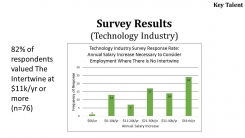 4. The Intertwine is a “second paycheck.” What employer wouldn’t love a little help meeting payroll? Well, this isn’t quite that, but employees do report that living in The Intertwine is like getting two checks instead of one. Joe completed an informal survey of area firms, with particular emphasis on technology companies (thank you, Technology Association of Oregon!) and outdoor and athletic (thank you, Portland Development Commission!). The value that employees put on that second check is higher than you might guess. See the results for the technology sector here. (Other sectors showed comparable results.)
4. The Intertwine is a “second paycheck.” What employer wouldn’t love a little help meeting payroll? Well, this isn’t quite that, but employees do report that living in The Intertwine is like getting two checks instead of one. Joe completed an informal survey of area firms, with particular emphasis on technology companies (thank you, Technology Association of Oregon!) and outdoor and athletic (thank you, Portland Development Commission!). The value that employees put on that second check is higher than you might guess. See the results for the technology sector here. (Other sectors showed comparable results.)
5. The Intertwine demonstrates corporate ethos. Area firms report that locating to the Portland region, and being part of the region’s culture of stewardship, can be an authentic demonstration of corporate ethic. By “walking the talk,” companies strengthen their culture and build credibility with customers and employees alike. Here’s more from Scott Welch.
6. The Intertwine provides inputs to production. Clean water, especially, is a key input for everything from making chips to brewing beer, and nature is the most effective means anyone has ever discovered to deliver clean water. Brewmaster Christian Ettinger of Hopworks Urban Brewery sings the praises, and explains the importance, of Bull Run water.
7. The Intertwine helps companies attract talent. Our investments in parks, trails and natural areas gives our companies an edge in attracting talent. In fact, these amenities are one of the top reasons prospective employees are attracted to Portland companies. Kristin Dagg, talent acquisition team leader for Columbia Sportswear, often leads with information on The Intertwine when recruiting out-of-area talent She also reports that many of her recruits are “pre-sold” on the Portland regio, making her job that much easier. (Hear more from Kristin Dagg.)
Here’s more on this topic, from Intel Talent Advisor and Executive Search Recruiter Don Cooper.
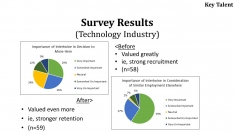 8. The Intertwine helps companies retain talent. Perhaps even more significant than The Intertwine’s power to attract talent is its power to retain it. In Joe’s informal survey, we discovered evidence that the value employees place on The Intertwine grows over time.
8. The Intertwine helps companies retain talent. Perhaps even more significant than The Intertwine’s power to attract talent is its power to retain it. In Joe’s informal survey, we discovered evidence that the value employees place on The Intertwine grows over time. 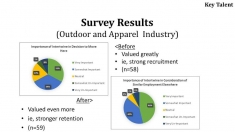 Here are the survey results for the outdoor athletic industry and the technology industry.
Here are the survey results for the outdoor athletic industry and the technology industry.
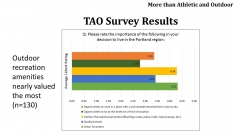 9. Even ranked against other great reasons to live here, The Intertwine rates as a primary factor in technology-sector talent coming to town. With the support of the Technology Association of Oregon, Joe was able to gather information from 130 area technology employees on what was most important to them in their decision to live in Portland. Even we were surprised by the results.
9. Even ranked against other great reasons to live here, The Intertwine rates as a primary factor in technology-sector talent coming to town. With the support of the Technology Association of Oregon, Joe was able to gather information from 130 area technology employees on what was most important to them in their decision to live in Portland. Even we were surprised by the results.
10. We have competition! Other metropolitan regions are developing their own “Intertwines.” We can’t expect to remain a market leader without continuing to invest. Intel's Don Cooper has this to say.
We recognize that much is left to do in deepening and validating these results, but we thank Joe for unearthing such great information and giving us such an excellent start. This project was funded by Metro and managed by The Intertwine Alliance. Joe’s full report is now available for download, or read his summary.

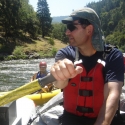 Intertwine Alliance Executive Director Mike Wetter has directed the coalition since its early days as a Metro initiative, before it became a formal nonprofit in 2011. Mike was chief of staff to former Metro Council President David Bragdon, and a business consultant for 13 years serving public, private and nonprofit clients. A visionary leader full of creative ideas, he's an avid whitewater rafter, kayaker, cyclist and hiker.
Intertwine Alliance Executive Director Mike Wetter has directed the coalition since its early days as a Metro initiative, before it became a formal nonprofit in 2011. Mike was chief of staff to former Metro Council President David Bragdon, and a business consultant for 13 years serving public, private and nonprofit clients. A visionary leader full of creative ideas, he's an avid whitewater rafter, kayaker, cyclist and hiker.
Comments
Green Infrastructrue Jobs
reply to "Green Infrastructure Jobs"
Add new comment